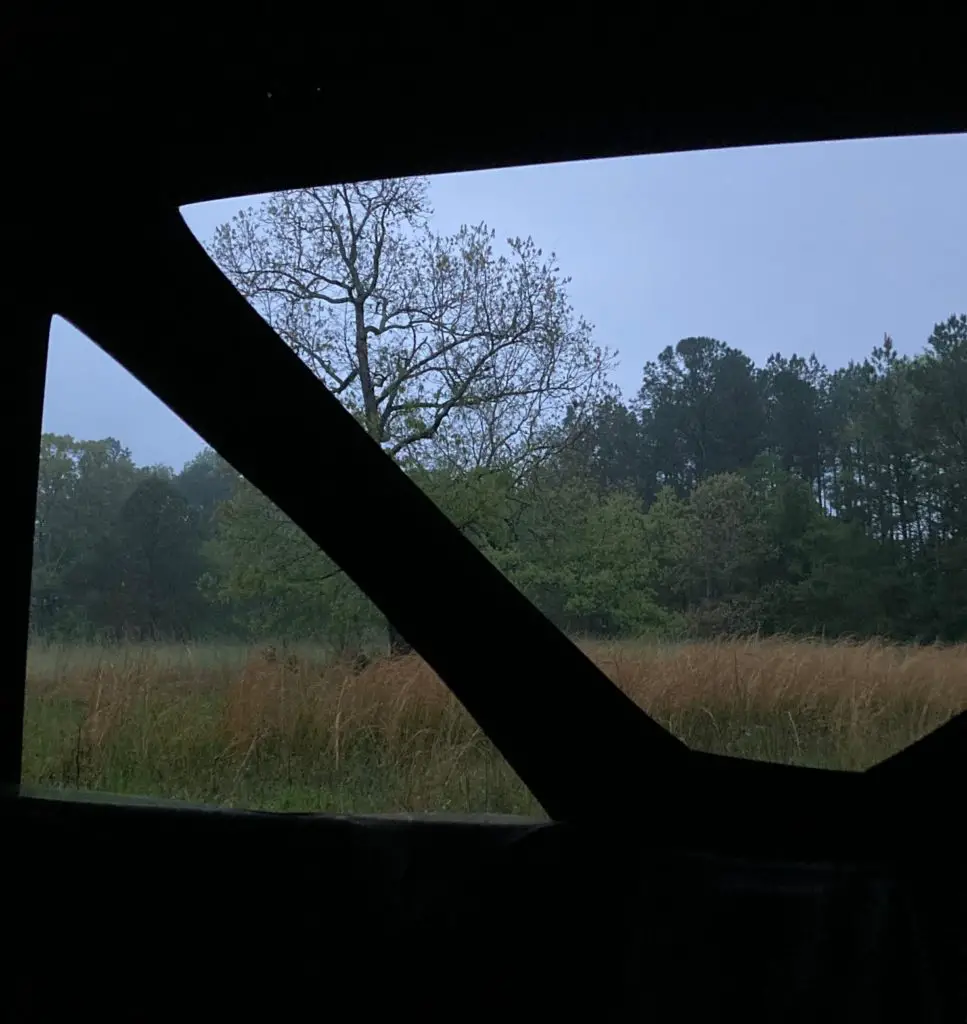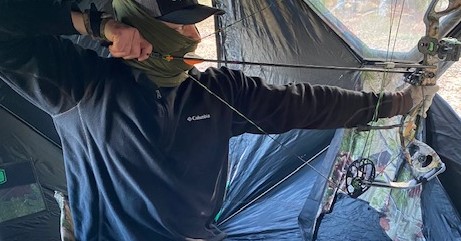
Are you ready for one of the toughest challenges in the sport of bowhunting? Then read on because I’m going to walk you through everything you need to know about bowhunting turkeys.
Trying to draw a bow on an animal with the vision and wariness of a turkey is a lot of fun. It will require you to change up some of the things you do when turkey hunting with a shotgun. Not only will you be using different equipment, you may also need to change your tactics just a bit.
Let’s start by making sure you are properly outfitted for the task.
Equipment for Bowhunting Turkeys
Your Bow
No need to go out and buy a new bow… ok, if you want to buy a new bow, you can tell the wife we said you needed one. However, the bow you use for hunting deer or elk will work just fine. There are some adjustments you should make though.
If you generally shoot a bow with more than a 50-pound draw weight, consider dialing it back to 50 pounds. There are several reasons for this.
The first reason is that a turkey is not as hard to penetrate with an arrow as a deer is. 50 pounds is more than sufficient to punch that broadhead to the vitals. Unlike deer or elk, you do not want the arrow to pass through. Turkeys do not leave a good blood trail. Therefore, it is advantageous if the arrow stays in the turkey to slow him down if the hit is not immediately fatal.
The second reason you don’t want your bow set to a high draw weight is because of the turkey’s wariness. When you are bowhunting turkeys, you want to be able to draw back as discretely as possible. You also need to be able to hold that draw until a good shot presents itself. Depending on the turkey’s demeanor, you could be stuck at full draw for a long time waiting for that gobbler to come in.
Now that we’ve figured out how to get your bow into turkey hunting shape, let’s talk about the broadhead you’re going to need.
Choosing a Broadhead
Like trucks, women, and music everyone has a different preference when it comes to turkey hunting broadheads.
Some folks believe that aiming for the head and neck of a turkey will either result in a clean kill or a clean miss. Obviously, this is a very small target so you will have to be extremely accurate. Turkey hunters aiming for the head and neck area use a broadhead designed specifically for this purpose.
The Magnus Bullhead is a fixed blade broadhead in 100 and 125 grains. The 100-grain version features a 2.75 inch wide cutting diameter to give you some forgiveness when aiming for the turkey’s upper extremities. Magnus is well known for both its customer service and product quality.
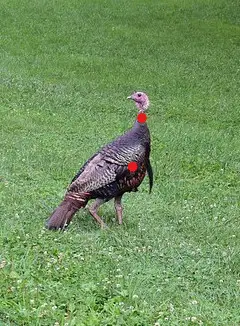
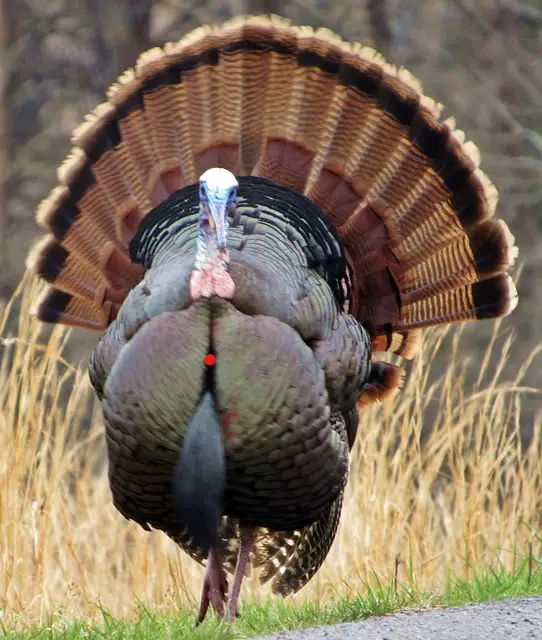
The other side of the coin is the group that aims for the body of the turkey. Be sure to carefully study a chart of the turkey’s vitals carefully. It can be helpful to practice shooting a 3D turkey target to get used to quickly aiming and shooting the right area.
The most common points to aim for are the top of the thigh when the turkey is broadside, between the beard and neck when the turkey is facing the shooter, and just above the anus if the bird is facing away from the shooter. Avoid shooting at a broadside turkey in full strut as it can be difficult to identify the proper place to aim.
Most people who make body shots on a turkey choose a large mechanical broadhead. Not only does it give a large cutting diameter to help hit small vitals, but it also loses energy as it expands upon impact. This helps keep the arrow from passing through the turkey completely.
For these hunters, it’s hard to beat the Rage Hypodermic broadhead which boasts a 2-inch cutting diameter. Rage mechanical broadheads seem to be as reliable as any mechanical on the market today, but others such as the NAP Spitfire and the Swhacker 2 Blade are also great choices.
Finally, there are hunters who choose fixed-blade broadheads because they feel they shoot them best. They believe that they are most accurate with their setup and they give them the best chance of hitting the small vital area of a turkey. One advantage fixed-blade broadheads have over mechanicals is the ability to shoot them through the mesh of a blind. This allows you to max out your concealment when bowhunting turkeys from a blind.
When it comes to fixed-blade broadheads for body shots on turkeys, I have long been a fan of Slick Trick Magnum broadheads. Slick tricks fly very similarly to your field points making for easy tuning and sighting in. The Magnums have an impressive cutting diameter as well.
Use a sharpie to darken your broadheads as well as your fletchings. This will keep your arrows from catching the eye of a wary gobbler.
Tactics for Bowhunting Turkeys
Because the wild turkey is so wary with such good eyesight, the most common tactic for bowhunting turkeys is to use a blind and decoys. However, there are many turkey hunting purists who still enjoy “running and gunning (bowing?).”
Let’s look into the basics of using blinds and decoys.
Blinds
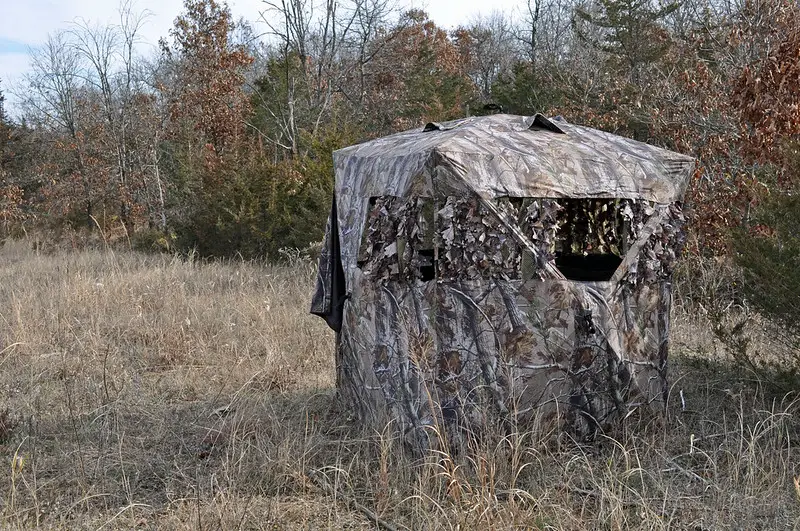
For the most part, turkeys tend to ignore blinds much more than a deer. There are highly pressured turkeys, particularly on public land, who will shy away from blinds. For these turkeys it may be necessary to brush in your blind with surrounding foliage to make it look more natural.
You will want to keep as many windows closed as possible on your blind to keep it dark inside. Obviously, you will need enough open to successfully shoot out at the turkey. Try to keep windows all the windows at your back closed.
Many people will wear all black inside the blind to blend in with the inside of the blind. While camouflage can also be fine, be sure to cover your face, arms, and hands fully in some sort of dark clothing. I like to wear a three-quarters facemask or neck gaiter pulled up so that I can still touch my anchor points (ear lobe and nose) when shooting a bow. You don’t want a bulky facemask interfering with your draw.
Keep in mind that your blind may restrict your ability to shoot from certain positions. Try to practice shooting with the blind, stool, and clothing you plan to use ahead of time. The Barronett Big Mike blind is great because it allows you to shoot from a standing position which is how most people practice.
Running and Bowhunting Turkeys
For many turkey hunting enthusiasts, sitting in a blind and waiting on the bird to come to you is not true turkey hunting. These purists find the thrill in going to the gobbling turkey.
While even more challenging, it is possible to bowhunt turkeys without a blind. Obviously, full camo is a must. Consider adding camo netting or leafy material to your bow to blend in even better. For more information on what to wear turkey hunting, read this article.
Your setup here will be one of the biggest factors in your success with this method. Choose a large tree or brush as a backdrop. You want something large enough to hide your silhouette. What’s behind you is more important than what is in front of you, but getting behind some brush or rock doesn’t hurt either.
You will need to draw when you can hear the tom coming in, but he can’t see you. You can also draw when the turkey’s head is behind a tree or some other brush. This is why it’s important to turn your draw weight down. You may be holding at draw for a long time.
Choosing and Setting Decoys
Decoys really help when bowhunting turkeys because they give the turkey a visual to focus on. If you don’t have decoys, a turkey is going to continue scanning and searching hard for the hen turkey calling to him. This makes him more likely to see you.
Today’s decoys are extremely realistic which is great for hunting turkeys that have been highly pressured. Dave Smith Decoys and Avian X are the two top options on the market.
A jake decoy paired with a hen decoy can be irresistible to a tom. Just using a hen by itself can sometimes cause a tom to hang up out of range. The tom struts and gobbles to try to make the “hen” come to him. With a jake nearby, the tom will come in quickly to try to kick his competition’s butt. Full strut tom decoys can be intimidating to other toms.
I like the three-quarter strut jake position. A hen feeder or lookout hen work well. I find the breeder hen position can be harder to make visible in higher grass setups.
Set your decoys approximately 5 to 7 yards from your shooting spot. You want these turkeys in close. Have the jake facing you. The tom will come in and go face-to-face with the jake, consequently, putting his back to you. This gives you the freedom to draw and take the backside shot on him.
Calling Turkeys
Because drawing and shooting a bow requires both hands, I use mouth calls a lot when bowhunting. If you mostly use friction calls, brush up with your diaphrams to free up your hands.
Calling sequences are, for the most part, the same as turkey hunting with a shotgun. You want to make sure you are solid on soft calling for getting toms close enough for a good shot with your bow. Light clucking and purring may be necessary to seal the deal.
Conclusion
Turkeys are hard to hunt with firearms. Taking it to the next level with a bow can be both rewarding and frustrating.
With the right equipment and tactics, you should be prepared to take on the challenge. I recommend using as many “crutches” as you can at first. Once you’ve killed a turkey with a blind and decoys, then consider dropping the blind and eventually the decoys.
Most importantly, find what works for you. This is for fun. There is no right or wrong way to hunt.
Let me know if you have any other suggestions on bowhunting turkeys in the comments below.

